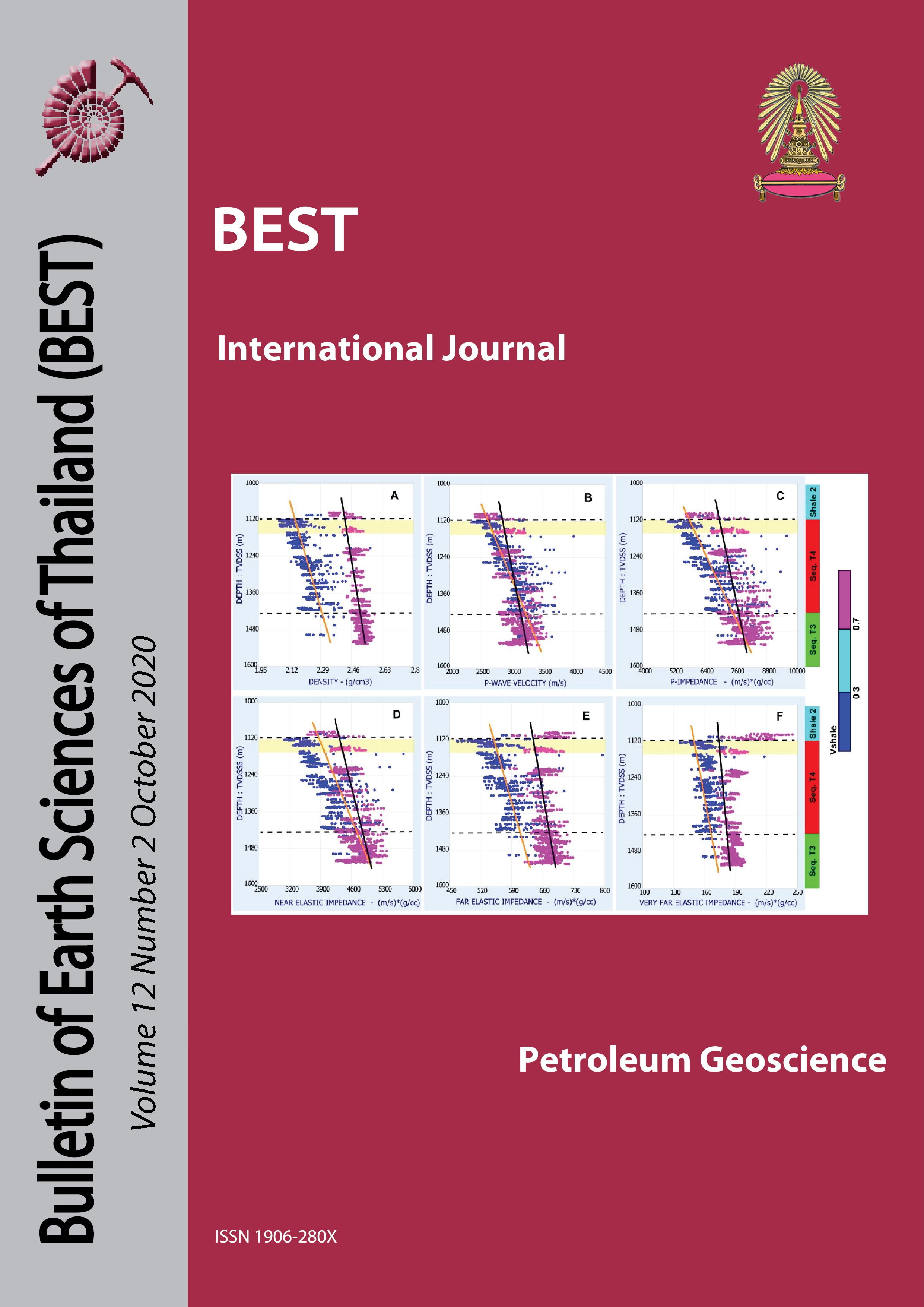Hydrocarbon and Reservoir Mapping Using Seismic Simulated Annealing Inversion, in Southern Pattani Basin, Gulf of Thailand
Main Article Content
Abstract
The research was conducted in southern Pattani Basin, Gulf of Thailand that is known as a mature hydrocarbon play. The sands reservoirs of sand A and sand B were studied by using seismic P-impedance inversion to image the oil-bearing reservoir distribution. Although several wells have been drilled, other areas haven’t been proven to develop the reservoir due to a lack of wells drilled in the northern and southern areas. Therefore, this research conducted to mapping the distribution of oil-bearing sand at those areas. Rock physic analysis indicates that interest zone have low-density and can be discriminated against other lithology. Full-stack and partial stack seismic data were inverted producing absolute and relative impedance volumes which were compared to distinguish the best techniques for imaging the reservoir. Absolute impedance volume has more reliable results and is used to differentiate oil-bearing sand with other lithologies. According to rock physic and absolute p-impedance analysis, porous sand and different lithologies (tight sand and shale) have significant impedance contrast. Porous sand has low impedance value and the impedance of tight sand and shale fall in the high range. Multi-well blind tests show a reasonable match. Reservoirs distribution observed using horizon slices indicate sand A shows a large and broad reservoir zone that is hard to identify in the interest zone. The sand B is smaller and identified as alluvial fan deposited in the lacustrine environment. This research indicates that full-stack absolute impedance inverted volume can be used to identify oil-bearing sand distributions. Inverted volume cannot fully differentiate oil-bearing sand apart with wet-sand. However, in most cases, oil-bearing sand can be predicted.
Article Details

This work is licensed under a Creative Commons Attribution-NonCommercial-NoDerivatives 4.0 International License.
Copyright © 2008 Department of Geology, Faculty of Science, Chulalongkorn University. Parts of an article can be photocopied or reproduced without prior written permission from the author(s), but due acknowledgments should be stated or cited accordingly.
References
Buangam, J. 2011. The stratigraphic trap in the Benchamas field, Pattani basin, Gulf of Thailand. Bulletin of Earth Sciences of Thailand, v. 4, p. 46-52.
Charusiri, P., and Pum-In, S. 2009. Cenozoic tectonic evolution of major sedimentary basin in central, northern, and the Gulf of Thailand. Bulletin of Earth Sciences of Thailand, v. 2, p. 40-62.
Ginting, H. B. R., Firmansyah, M., Ariansyah M. R., Aswad, S., and Siregar, D. R. 2019. Reservoir characterization using acoustic impedance seismic inversion method and seismic attribute in the “RST” field of the Taranaki basin, New Zealand. Proceedings Indonesian Petroleum Association, Jakarta, Indonesia, No. IPA19-SG-41.
Morley, C. K., and Racey, A. 2011. Tertiary stratigraphy, in MF Ridd, A. J. Barber and M. J. Crows, eds., The geology of Thailand. Journal of Geological Society of London, p. 223-271.
Phoosongsee, J., Morley, C. K., and Ferguson, A. J. 2019. Quantitative interpretation of seismic attributes for reservoir characterization of early-middle Miocene syn- and post-rift successions (Songkhla basin, Gulf of Thailand. Journal of Marine and Petroleum Geology, No. 109 (2019), p. 791-807.
Tang-On, A. 2018. The use of inversion volumes for reservoir imaging, CU field, Gulf of Thailand. Unpublished M.Sc. thesis, The Department of Geology, Faculty of Science, Chulalongkorn University.
Trevena, A. S., and Clark, R. A. 1986. Diagenesis of sandstone reservoirs of Pattani Basin, Gulf of Thailand. The American Association of Petroleum Geologists Bulletin, v.70, No.3, p. 299-308.
Watcharanantakul, R., and Morley, C. K. 2000. Syn-rift and post-rift modeling of the Pattani basin, Thailand: evidence for a ramp flat detachment. Journal of Marine and Petroleum Geology, v. 17 (2000), p. 937-958.


